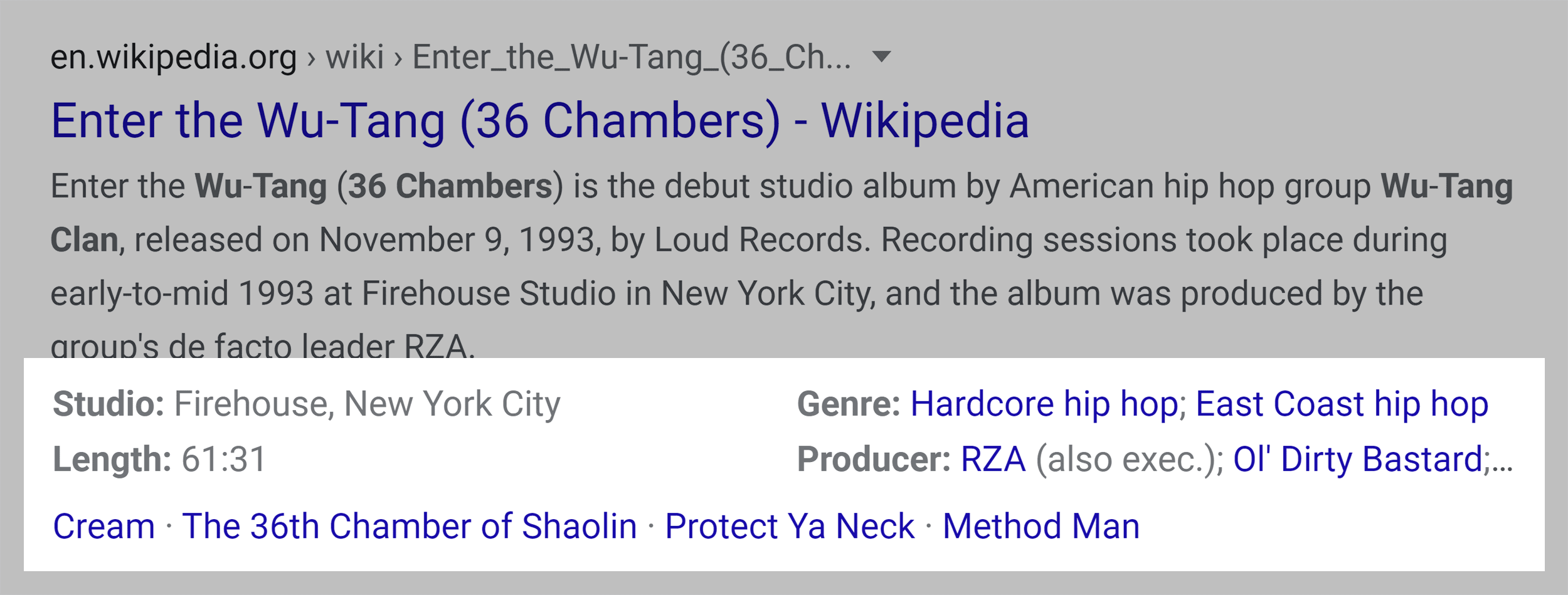Optimizing Google Rich Snippets for Stronger SEO

Interesting name, isn’t it? Rich snippets. Inviting, like someone sharing some juicy piece of information. You might have encountered the term thrown around in the context of SEO — and we bet you’ve seen it when you do a Google search as well. So, what exactly are rich snippets? How do Google’s rich snippets work? What is a rich snippet tool? We have the answers to all your pressing questions right here — keep reading.
What are Rich Snippets?
Rich snippets, rather like the name itself suggests, simply involve a little extra addition to your regular garden variety search engine results. Rich snippets are also sometimes called rich results — which can help you see what they do! Google rich snippets draw on data on website pages through their structured data, which are special pieces of information coded into a page’s HTML coding, which can then be used by search engines to add a little sugar and spice to whatever it is you’re looking for. Rich snippets examples include product ratings with stars, FAQ sections in search results, and event details with dates and locations. These enhanced snippets improve SEO visibility and click-through rates, making search results more engaging and informative for users.
Let’s say you’re looking to make weekend plans and turn to Google: for an easy weekend brunch recipe or concert tickets, for example. You’ll find that some results come with extra information, from recipe details and cook times to ticket prices and even date, time, and location information. These are rich snippets in action!
Rich Snippets vs Rich Results vs Featured Snippets – Understanding the Difference
Want to know how to get rich snippets? Before we get into how rich snippets can benefit your online presence — a lot, at that! — let’s take a quick dive into some keywords you might have encountered.
Rich snippets — also called rich results, sometimes — are, as we’ve established already, results with extra interactive or visual elements to give you a sense of what you’ll find when you click through. Rich snippets are based on the structured data you provide in your page’s HTML.
Featured snippets, on the other hand, show up in a nifty little highlighted box at the top of your search engine. Featured snippets are like neon signs on top of a list of results saying hey, pick me! Featured snippets, unlike Google rich snippets, draw from your on-page and technical SEO — which the search engine does for you.
Featured snippets are dependent on their ranking: search engines will give you that coveted neon sign only if you already rank in the top ten results for that specific query. Rich snippets, on the other hand, are specific to the content type on your page, such as a recipe, reviews, or even product prices. And finally: SERPs. This one is pretty simple: SERP stands for search engine results pages and simply refers to the search engine you or your users are using to perform searches. The results page is essentially the battleground of SEO: this is where you’re fighting it out with other pages for ranking — and where all your rich snippets will appear.
How to Implement Schema Markup for Rich Snippets?
Wondering how to create rich snippets? Schema markup is the foundation of rich snippets SEO, allowing search engines to understand and display additional details about a webpage. To implement it, use structured data formats like JSON-LD (Google’s preferred method), Microdata, or RDFa.
The first step is identifying the most relevant schema type, such as Product, Recipe, FAQ, or Event. Then, add the appropriate structured data to your webpage’s HTML. Google’s Rich Results Test Tool helps validate your markup and ensure proper implementation.
Using Google Tag Manager can simplify adding structured data without modifying code directly. Additionally, structured data plugins in CMS platforms like WordPress can automate schema markup insertion.
Once implemented, monitor Google Search Console for any errors or warnings. Properly optimized schema markup improves search visibility, increasing click-through rates (CTR) and user engagement. Consistently updating and validating markup ensures long-term effectiveness in search rankings.
Common Mistakes to Avoid When Implementing Rich Snippets
While rich snippets SEO can significantly boost search performance, common mistakes can prevent them from appearing. One of the biggest errors is using incorrect or misleading structured data. If Google detects discrepancies between your markup and page content, your rich snippets won’t show up.
Another frequent mistake is overusing schema markup. Not every page needs structured data, and applying unnecessary markup can lead to penalties. Ensure you use Google-supported schema types to avoid errors.
Failing to update structured data regularly is another issue. If product availability, prices, or reviews change, but the schema markup remains outdated, search engines may flag inconsistencies.
Additionally, some websites implement schema incorrectly by placing structured data in the wrong section of their HTML, making it unreadable to search engines.
To avoid these pitfalls, always test your structured data using Google’s Rich Results Test and monitor Google Search Console for warnings.
How Do You Optimize for a Rich Snippet?
To improve the chances of earning a rich snippet, start with well-structured content that directly answers search queries. Google favors content that provides clear, concise, and authoritative information.
Using structured heading tags (H1, H2, H3), bullet points, and tables can improve readability and make it easier for search engines to extract relevant content. Answering questions using a Q&A format increases the likelihood of securing FAQ-rich snippets.
Ensure structured data markup is implemented correctly using JSON-LD and validated through Google’s Rich Results Test. Pages with proper schema markup stand a better chance of appearing as rich snippets.
Content that matches search intent is more likely to be featured. Focus on long-tail keywords, provide step-by-step guides, and use clear definitions to improve snippet eligibility.
Finally, track performance using Google Search Console to see which pages generate snippets and refine strategies accordingly.
Measuring Rich Snippets Performance
Tracking the performance of rich snippets is crucial to understanding their impact on SEO. Google Search Console provides Rich Results reports, showing which structured data types appear in search results and identifying errors affecting visibility.
One key metric to monitor is click-through rate (CTR). Rich snippets often improve CTR by making search listings more engaging. If a page has structured data but no increase in CTR, refining meta descriptions and content structure may help.
Analyzing impressions vs. clicks gives insights into whether rich snippets generate traffic. A high number of impressions but low clicks may indicate the snippet isn’t compelling enough.
Using tools like Google Analytics helps track user behavior post-click. Pages with rich snippets should ideally have lower bounce rates and higher engagement.
Regularly testing structured data using Google’s Rich Results Test ensures schema remains valid, preventing errors that might cause rich snippets to disappear.
Future Trends: What’s Next for Rich Snippets?
As AI-driven search evolves, rich snippets will become even more dynamic. Google is integrating machine learning to provide contextual search results, meaning snippets may adapt based on user intent.
Voice search is also influencing rich snippet optimization. Since voice assistants pull answers from featured snippets, optimizing content for conversational queries will be crucial.
Another emerging trend is interactive rich snippets, where users can engage with elements like expandable FAQs or live product availability updates directly from SERPs.
With Google’s evolving algorithms, maintaining structured data accuracy will be essential. Future search enhancements may prioritize real-time data, favoring sites that provide up-to-date product pricing, stock levels, and user-generated content.
Businesses must stay ahead by consistently optimizing schema markup, ensuring content aligns with Google’s latest rich snippet guidelines, and adapting to new SERP features to maintain visibility.
What are the Different Types of Rich Snippets?
Given that different web pages will offer different things, it stands to perfect reason that rich snippet types will vary too. Google rich snippets, consequently, come in a variety of flavors and functions, including the movie snippet, event snippet, product snippet, review snippet, music snippet, and recipe snippet.
Movie Snippet
The movie snippet shows you summarized information about a movie, from its runtime and release date to genre and even where it might be streamed or bought.
Event Snippet
Event snippets give you the most important information about events such as concerts, including when and where it’s happening and whether tickets are for sale and where you can buy them.
Product Snippet
This kind of rich snippet is invaluable to eCommerce businesses — it shows you how much a product costs, whether it’s on sale, where it can be bought, and even how other buyers rated it.
Review Snippet
This rich snippet shows you how much other users liked something through a star rating!
Music Snippet
Music snippets show you information about any song or album you searched for — who composed it, who wrote the lyrics, when it came out, etc.
Recipe Snippet
This kind of rich snippet tool can offer lots of pertinent information related to your searches, such as nutritional information, cooking time, and the ingredients you’ll need.
How Do Rich Snippets Help SEO?
The additional information that rich snippets bring to your appearance on SERPs can make a big difference when it comes to your website’s reach. Most search engine results show you the same set of information across the board which they derive from the page in question’s title tag, URL, and meta description. Rich snippets, on the other hand, as you have likely already experienced firsthand, offer more information organized in a way that’s quite easy on the eyes.
This added visibility, thanks to rich snippets, can help you garner that coveted organic click through rate. Although Google has previously made it clear that structured data in and of itself isn’t a ranking factor, consistent click through and playing well with search engine rules can only bring you good returns in the long run.
Here are some of the incredible advantages of using rich snippets in your SEO strategy:
You get the user’s nearly undivided attention.
Because Google rich snippets are designed to stand out and offer the most relevant information in relation to a search in a snappy form, you have your target users paying attention to what’s on your table.
The most important information comes first.
Whether you’re offering recipes or a great new product with rich snippets, all the most important information is already front and center before your target users.
Conclusion
Google rich snippets are an incredibly valuable tool in an economy that increasingly runs on attention. Rich snippet tools are an excellent way to boost your CTR and visibility in the long run. Your best friend on this road — the ultimate rich snippet tool, structured data.
While the technical-sounding term might make you want to scream and run for the hills, partnering with an industry-expert digital marketing firm like AdLift can help you take your rich snippets to the next level and reap all those delicious SEO fruits.







